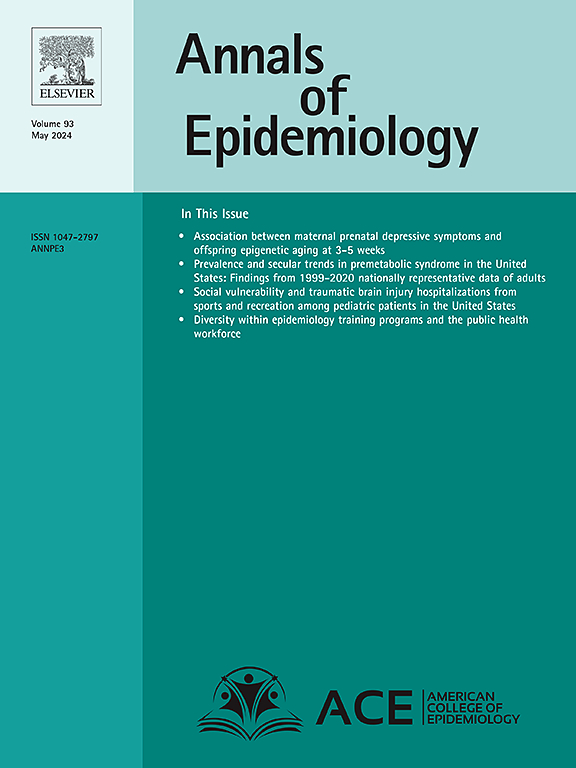在COVID-19大流行之前和期间,社区剥夺和种族差异与严重孕产妇发病率有关
IF 3.3
3区 医学
Q1 PUBLIC, ENVIRONMENTAL & OCCUPATIONAL HEALTH
引用次数: 0
摘要
目的探讨在COVID-19大流行之前和期间,严重孕产妇发病率(SMM)的种族和民族差异是否在所有社区或主要在资源匮乏社区有所增加。方法:本研究使用密歇根州2017年1月1日至2021年10月31日期间出生记录和医疗补助索赔的全州关联数据库(N = 214,406)。邻域剥夺采用面积剥夺指数(Area deprivation Index)来衡量,并进行分类。采用中断时间序列方法的多水平logistic回归比较了低、中、高贫困社区大流行前(2017年1月至2020年2月)和大流行期间(2020年3月至2021年10月)SMM的种族和民族差异。结果疫情期间最贫困社区的黑人-白人差异扩大(调整风险比,aRR[95 % CI]: 1.72 [1.54, 1.92];与大流行前相比,超额病例[95 % CI]: 201.7 [159.0, 244.5]) (aRR[95 % CI]: 1.23 [1.12, 1.35];超额病例[95 % CI]: 75.4 [41.2, 109.5], p <; .001),但在最贫困和中等贫困社区持续存在(未扩大)。结论大流行期间SMM的种族和民族差异扩大仅在最贫困的社区中观察到,而不是在社区背景下普遍存在。需要社区参与的解决方案来改善社区条件,并在危机期间减少孕产妇保健不公平现象。本文章由计算机程序翻译,如有差异,请以英文原文为准。
Neighborhood deprivation and racial disparities in severe maternal morbidity before and during the COVID-19 pandemic
Purpose
To examine whether racial and ethnic disparities in severe maternal morbidity (SMM) increased across all neighborhoods or mainly in resource-deprived neighborhoods before and during the COVID-19 pandemic.
Methods
This study used Michigan’s statewide linked databases from birth records and Medicaid claims between 01/01/2017 and 10/31/2021 (N = 214,406). Neighborhood deprivation was measured with Area Deprivation Index and categorized into tertiles. Multilevel logistic regressions with an interrupted time series approach were used to compare racial and ethnic disparities in SMM pre-pandemic (January 2017-February 2020) and during the pandemic (March 2020-October 2021) in low, medium, and high deprivation neighborhoods.
Results
The Black-White disparity in the most deprived neighborhoods widened during the pandemic (adjusted risk ratio, aRR [95 % CI]: 1.72 [1.54, 1.92]; excess cases [95 % CI]: 201.7 [159.0, 244.5]) compared to pre-pandemic (aRR [95 % CI]: 1.23 [1.12, 1.35]; excess cases [95 % CI]: 75.4 [41.2, 109.5], p < .001), but persisted (not widened) in the least and medium deprived neighborhoods.
Conclusions
Widening racial and ethnic disparities in SMM during the pandemic were only observed in the most deprived neighborhoods, rather than being universally prevalent across neighborhood contexts. Community-engaged solutions are needed to improve neighborhood conditions and reduce maternal health inequities during times of crisis.
求助全文
通过发布文献求助,成功后即可免费获取论文全文。
去求助
来源期刊

Annals of Epidemiology
医学-公共卫生、环境卫生与职业卫生
CiteScore
7.40
自引率
1.80%
发文量
207
审稿时长
59 days
期刊介绍:
The journal emphasizes the application of epidemiologic methods to issues that affect the distribution and determinants of human illness in diverse contexts. Its primary focus is on chronic and acute conditions of diverse etiologies and of major importance to clinical medicine, public health, and health care delivery.
 求助内容:
求助内容: 应助结果提醒方式:
应助结果提醒方式:


